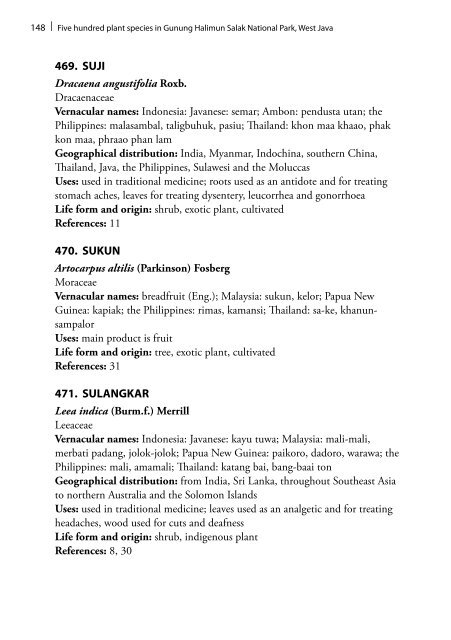Five hundred plant species in gunung Halimun Salak ... - CIFOR
Five hundred plant species in gunung Halimun Salak ... - CIFOR
Five hundred plant species in gunung Halimun Salak ... - CIFOR
Create successful ePaper yourself
Turn your PDF publications into a flip-book with our unique Google optimized e-Paper software.
148 | <strong>Five</strong> <strong>hundred</strong> <strong>plant</strong> <strong>species</strong> <strong>in</strong> Gunung <strong>Halimun</strong> <strong>Salak</strong> National Park, West Java<br />
469. SUJI<br />
Dracaena angustifolia Roxb.<br />
Dracaenaceae<br />
Vernacular names: Indonesia: Javanese: semar; Ambon: pendusta utan; the<br />
Philipp<strong>in</strong>es: malasambal, taligbuhuk, pasiu; Thailand: khon maa khaao, phak<br />
kon maa, phraao phan lam<br />
Geographical distribution: India, Myanmar, Indoch<strong>in</strong>a, southern Ch<strong>in</strong>a,<br />
Thailand, Java, the Philipp<strong>in</strong>es, Sulawesi and the Moluccas<br />
Uses: used <strong>in</strong> traditional medic<strong>in</strong>e; roots used as an antidote and for treat<strong>in</strong>g<br />
stomach aches, leaves for treat<strong>in</strong>g dysentery, leucorrhea and gonorrhoea<br />
Life form and orig<strong>in</strong>: shrub, exotic <strong>plant</strong>, cultivated<br />
References: 11<br />
470. SUKUN<br />
Artocarpus altilis (Park<strong>in</strong>son) Fosberg<br />
Moraceae<br />
Vernacular names: breadfruit (Eng.); Malaysia: sukun, kelor; Papua New<br />
Gu<strong>in</strong>ea: kapiak; the Philipp<strong>in</strong>es: rimas, kamansi; Thailand: sa-ke, khanunsampalor<br />
Uses: ma<strong>in</strong> product is fruit<br />
Life form and orig<strong>in</strong>: tree, exotic <strong>plant</strong>, cultivated<br />
References: 31<br />
471. SULANGKAR<br />
Leea <strong>in</strong>dica (Burm.f.) Merrill<br />
Leeaceae<br />
Vernacular names: Indonesia: Javanese: kayu tuwa; Malaysia: mali-mali,<br />
merbati padang, jolok-jolok; Papua New Gu<strong>in</strong>ea: paikoro, dadoro, warawa; the<br />
Philipp<strong>in</strong>es: mali, amamali; Thailand: katang bai, bang-baai ton<br />
Geographical distribution: from India, Sri Lanka, throughout Southeast Asia<br />
to northern Australia and the Solomon Islands<br />
Uses: used <strong>in</strong> traditional medic<strong>in</strong>e; leaves used as an analgetic and for treat<strong>in</strong>g<br />
headaches, wood used for cuts and deafness<br />
Life form and orig<strong>in</strong>: shrub, <strong>in</strong>digenous <strong>plant</strong><br />
References: 8, 30

















